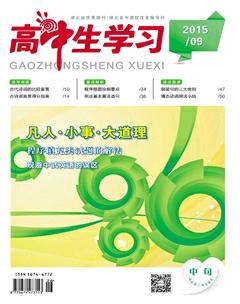倒装句的三大类别
袁黎 胡同梅
倒装是高中英语语法的重要组成部分,分为语法倒装和修饰倒装。根据倒装方式的不同又可将其分成三类,即全部倒装、部分倒装、强调部分提前与主谓顺序无关的倒装。例如:
I write a book.
全部倒装为: Write I a book. (全部倒装要将整个谓语部分提到主语的前面)
部分倒装为: Do I write a book. (部分倒装就是将原句变为一般疑问句)
强调部分提前与主谓顺序无关的倒装为: a book I write.
一、全部倒装
1. 以副词如:表示地点的副词here/there,表时间的副词now/then,表位移的副词up/down, in/out, away, off 等开头,且主语为名词的句子要全部倒装。例如:
①The bus comes here.
倒装句为:Here comes the bus.
(此句满足了以上两个条件:以副词开头;主语是名词)
②When the bell rang, the children rushed out.
倒装句为:When the bell rang, out rushed the children.
注意:下面这样的句子就不能全部倒装。
③He came here.
只能改为: Here he came.
(此句只满足了副词开头的条件,而另一个条件,主语必须是名词没有满足,故不能改成全部倒装句)
2. 表示方位的介词短语开头(不管介词短语是在主句的开头还是在从句的开头)。例如:
①A boy stood in front of the classroom.
倒装句为: In front of the classroom stood a boy.
②A little girl sat between the old couple.
倒装句为:Between the old couple sat a little girl.
③I used to live in a small village, throught which flowed a river.
陈述句为: A small river flowed a river.
④When we got to the playground, we found a sign on which was written “wet paint”.
陈述句为:“wet paint” was written on the sign.
3. 表语提前的倒装(一般情况下含有be动词的短语构成的句子都可以变成表语提前的倒装形式)。例如:
①Chairman Xi was present at the meeting.习主席出席了这次会议。
倒装句为:Present at the meeting was Chairman Xi. 出席会议的有习主席。
②Some students were seated on the ground. 一些学生坐在地上。
倒装句为: Seated on the ground were some students. 地上坐着一些学生。
③His father is following him. 他的爸爸正跟着他。
倒装句为:Following him is his father. 跟着他的是他的爸爸。
④Some tools he used when he was alive were buried with him. 一些他生前使用过的工具和他埋在一起。
倒装句为:Buried with him were some tools he used when he was alive. 和他埋在一起的是一些他生前使用过的工具。
二、将句子变为一般疑问句的部分倒装
1. only加状语开头,例如:
①We can achieve success only by working hard.
倒装句为:Only by working hard can we achieve success.
②I go to school on foot only when it rains.
倒装句为:Only when it rains do I go to school on foot.
③The whole thing makes sense only if you show us the evidence.
倒装句为:Only if you show us the evidence does the whole thing make sense.
④I realized that I would feel relieved only if I shared my feelings with my friends.
倒装句为: I realized that only if I shared my feelings with my friends would I feel relieved.
2. 以否定词或否定短语开头的句子。如否定词 never, seldom, little, nowhere, hardly, not等,否定短语in no case, by no means, on no account, under no circumstances, at no time等。例如:
①By no means will I help you with your trouble.
陈述句为: I will by no means help you with your trouble.
②陈述句: I have never heard such nonsense in all my life.
倒装句为: Never have I heard such nonsense in all my life.
③陈述句: I didnt say a word at the meeting.
倒装句为: Not a word did I say at the meeting.
④陈述句: The car was nowhere to be found. 倒装句为: Nowhere was the lost car to be found.
注意:句型hardly ... when, no sooner ... than, scarcely ... when的时态和倒装。例如:
①Hardly had I sat down when the doorbell rang.
②No sooner had I turned on the TV than he asked me to turn it off.
这两个句型中前面的主句一般用过去完成时态,后面的从句用过去时,翻译为“一……就……”。
另:not only ... but also ...的倒装,只倒装前半部分。例如:
Not only does she like English but also she is fond of maths.
陈述句为: She not only likes English but also she is fond of maths.
3. 为加强语气,“so(such) ... that ... ”结构中的so或such位于句首用倒装。例如:
①陈述句: She runs so fast that I cant catch up with her.
倒装句为: So fast does she run that I cant catch up with her.
②陈述句: She found such a valuable coin that she became very excited.
倒装句为: Such a valuable coin did she find that she became very excited.
注意:此句型只倒装前半句。
4. 如果前面句子中所说的情况也适用于后面的句子,后面的句子常用so(肯定句)、 nor或 neither(否定句)引导构成倒装句,并用do(does,did)代替实义动词。例如:
①They like swimming, so do I. (意思是:I like swimming, too.)
②she is used to living in the country, so am I.(意思是:I am used to living in the country, too.)
③The boy wasnt late for the class, neither was his deskmate. (意思是:His deskmate wasnt late for the class, either.)
④I dont know that you are here, nor do I care whether you are here.
注意:这种倒装句如果前后两句的“谓语+宾语”或者系表结构部分相同,则相同的部分省略,用do/does或系动词将替换掉。如果前后两句的谓语及其他部分不一样时,将所有的内容留下,句子变为一般疑问句的形式,如最后一个例句。
5. 虚拟语气中省略if的倒装
如果虚拟条件句中的谓语部分含有were, had或should,可以把if省略,将它们放在句首,变成倒装句。例如:
①陈述句: If it were to rain tomorrow, we would have to stay at home.
倒装句为: Were it to rain tomorrow, we would have to stay at home.
②陈述句: If I had taken an umbrella with me, I wouldnt have got wet all over.
倒装句为: Had I taken an umbrella with me, I wouldnt have got wet all over.
③陈述句: If you should act like that again, I would have you punished.
倒装句为: Should you act like that again, I would have you punished.
三、只将强调部分提前,主谓顺序不变的倒装
1.有as或though表示“尽管”的让步状语从句要倒装,其结构只将强调的形容词(副词,动词,分词等)放到句首,然后接上as(/though)加主语和谓语。
①Young as he is, he knows a lot. (前半句陈述语序为:as he is young, 倒装句中把young提到了句首)
②Child as he is, he is brave. (前半句陈述语序为:as he is a child, 倒装时将child提前,省略了冠词。这里特别注明当把名词提前时去掉冠词)
③Try as he will, he may fail again. (前半句的陈述语序为:as he wil try,将动词try提到了句首构成倒装。)
2.the more..., the more...句型的倒装。两个并列句表示“越……,就越……”的倒装方式与上面的规则一样,只将强调的部分提前改为比较级,主谓顺序不变。例如:
①The higher you stand, the farther you will see. 站得越高,看得越远。
陈述句为: You stand high, you will see far. (将句子中的high和far提前变为比较级加上the,构成倒装句)
②The harder you work, the more progress you will make.
陈述句为:You work hard, you will make much progress. (将句子中的hard和much progress变为比较级提前,加上the构成倒装句)
3.感叹句也是倒装句的一类。先写出陈述句,再把要强调感叹的词提前,在形容词前加how,名词前加what,就构成了感叹句。例如:
①陈述句: The children are happy. 孩子们很开心。
感叹句为:How happy the children are. 孩子们是多么开心呀!(happy是形容词, 所以以how开头。
②陈述句: I found a beautiful flower. 我发现了一朵漂亮的花。
感叹句为:What a beautiful flower I found. 或 How beautiful a flower I found.
注意:感叹句有三种结构:how+adj.+(a/an+n.)+主语+谓语;what+(a/an)+(adj.)+n+主语+谓语;how+adv.+主谓。

